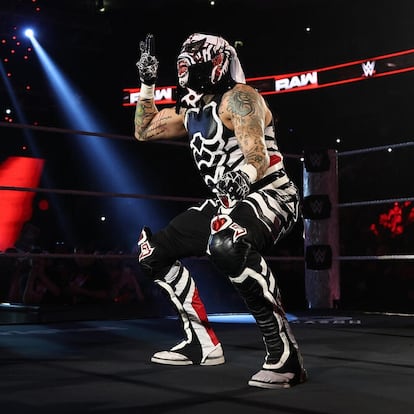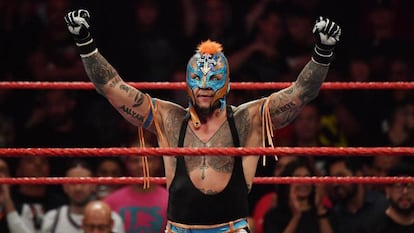Lucha libre is history, tradition, culture. The ring, the packed arenas, the eternal fight between the técnicos and the rudos, the shouts, the insults, the laughter, the colors, and everything that represents its tradition are all part of the Mexican sporting spectacle. In recent years, it has become an emblem, a symbol of national identity and pride. Some even dare to claim that the wrestler’s mask is a more representative symbol of the country than the sombrero. In short, it belongs to Mexicans. But what would happen if the whole package got acquired by a U.S. company? Some believe that, to use a soccer simile, it would be as if Liga MX were bought by MLS. Or even worse, as if Our Lady of Guadalupe, a depiction of the Virgin Mary venerated by Mexicans, were sold to China for exploitation.
Yet this is exactly what has happened. On April 19 in Las Vegas, it was announced that the leading Mexican lucha libre promotion AAA has been acquired by World Wrestling Entertainment (WWE), the largest and most important wrestling company in the world. Ahead of the most important event of this year’s sporting spectacle for the U.S. company, WrestleMania, with wrestlers standing behind him and shouts of “Lucha! Lucha! Lucha!” from fans in the background, AAA general manager Dorian Roldán said that this is the beginning of a new chapter for the sport.
The head of the Mexican company, along with his mother and company president, Marisela Peña, are heirs to a legacy that was started 33 years ago by his uncle Antonio Peña, who passed the baton to his father Joaquín Roldán until the latter’s death in 2017. The son announced the alliance with WWE and Fillip, a Mexican holding company specializing in revitalizing iconic sports and entertainment properties, with the goal of demonstrating that Mexican wrestling has a place on the global stage.
“What they’ve created is spectacular. We have nothing but respect for their product and for wrestling. Great athletes have come out of AAA. They’ve come to WWE and have been seen all over the world. The cultural impact they’ve had resonates through generations. [...] It’s incredible. We’re looking to continue that tradition. We’re going to take it to the next level,” said former wrestler and WWE Chief Content Officer Paul “Triple H” Levesque.
The announcement has sparked curiosity, suspicion, and even fantasies among fans — some seriously, others jokingly — about face-offs between characters from both companies, such as El Hijo del Vikingo (Son of the Viking) versus Roman Reigns or La Parka versus The Undertaker, to name a few. From an economic perspective, even though the numbers haven’t been revealed, it’s a good move, says Ernesto Campo, a journalist for the Superluchas media outlet.
 The Mexican wrestler Penta at his WWE debut, on Netflix.WWE
The Mexican wrestler Penta at his WWE debut, on Netflix.WWEHowever, from a cultural perspective, he feels it’s an appropriation. Even though the acquisition was announced as a collaboration between the three companies, “the truth is that it seems more like an absorption. Mexican lucha libre could be translated, reinterpreted, and ultimately domesticated,” he says.
The reality, according to Ocampo, is that WWE wants to penetrate the Mexican market. It has always sought to do so because it has a fan base deeply devoted to its product. However, for many years, companies like AAA and Consejo Mundial de Lucha Libre (CMLL) formed a kind of barrier, preventing the entry of the U.S. conglomerate founded in 1953 by Vincent J. McMahon, when it was still known as Capitol Wrestling Corporation.
Eduardo Bates, a wrestling marketing specialist, sees WWE’s expansion into the Mexican and Latin American markets as “a huge opportunity,” as it could bring with it better job opportunities, not only financially but also in the form of established contracts. He also believes that the acquisition of AAA could be an opportunity for improvement and growth for this national sporting event.
“I feel like Mexican wrestling has been stagnant for at least 15 years. The [World Wrestling Council] is doing the same old thing. In Triple A, we had a product that wasn’t the best. This move is very important to see the same effort from other promotions that are perhaps smaller, but still very good, like The Crash or Kaoz, to name a few,” says Bates.
WWE’s opening move to the Mexican market will begin in a big way. The alliance will take its first steps in Los Angeles with the Worlds Collide event, to be held on June 7. The 2025 card is expected to include wrestlers such as Pagano, Psycho Clown, La Parka and Laredo Kid, as well as other Mexican talents working for the U.S. company such as Penta, one of the most recent signings and originally from Ecatepec — as well as Mexican wrestlers such as Andrade, Rey Fénix and Rey Mysterio. It is an ambitious lineup that seeks to unite two styles and two cultures in a single high-voltage event.
This first event will be streamed by Netflix as part of a 10-year contract with WWE valued at $5 billion that makes the platform the exclusive streaming service for all of the wrestling company’s weekly shows, as well as its pay-per-view events in the United States, Canada, the United Kingdom and Latin America beginning in 2025.
WWE: things to improve
One of the biggest criticisms of WWE over the years is that it hasn’t managed or understood its Latino wrestling talent. Most of the time it has offered a folkloric portrayal of them, without giving them valuable space in the programming, the stories or the rivalries. It was always limited to a fight among Mexicans, rather than for opportunities or important titles.
Oporto calls WWE a “very racist” company in general, although they have sometimes been able to break free from prejudice. “If we look at what they do today, they put all Black wrestlers in rivalries against other Black wrestlers. The same thing happens with Latinos and Mexicans,” he adds.
Bates differs and believes that things have changed at the WWE. “Currently there is a lot of exposure of Mexican and Latin American talent in the ring. The most important thing is the connection with the people, and I think that Penta has shown that through his charisma; if we take away the fact that he is Mexican, if we simply talk about the person, the human being, the work he has done is incredible. He overflows with charisma and I think that is what has worked for him,” adds the marketing expert.
Both Bates and Oporto mention exceptions such as Eddie Guerrero and Rey Mysterio, both of Mexican descent, with a stint in AAA and more of a wrestler’s profile, who managed to capture the top title in the American company. Or the case of Alberto del Río, from San Luis Potosí, who triumphed due to his distinctive features, such as his height, muscular build, and command of the microphone in English, which took him to the top at a certain point in his career. The most recent success story within WWE is that of Penta, who has managed to participate in major pay-per-view events and rub shoulders with important stars such as John Cena and Roman Reigns.
 Rey Mysterio, on Raw.WWE
Rey Mysterio, on Raw.WWE“I think the landscape in WWE has changed. There’s a lot of exposure for Mexican and Latin American talent these days, many of them incredibly talented in the ring. The most important thing is connecting with people, and I think Penta has demonstrated that through his charisma. Putting aside the fact that he’s Mexican, just talking about the person, the human being, the work he’s done, which is incredible. He oozes charisma, and I think that’s what’s worked for him,” Bates adds.
Many questions remain about how WWE’s business will evolve in Mexico. For example, regarding the potential new talent and prospects that may emerge. “AAA may keep an eye on them and take them. With WWE’s help, it could become a company with too large a roster to shine a spotlight on everyone, but ultimately the goal may be to take over the market,” Bates reflects.
“Perhaps the expansion plans are not as ambitious as previously thought, because they are just exploring the market,” says Ocampo, adding that it remains to be seen how AAA talent will be handled internally in the Mexican wrestling market, since many wrestlers are called up by smaller promotions to headline their events. “It is possible that with the expansion of AAA, they will be more restrictive regarding the participation and selection of events for their stars,” Ocampo specifies.
Mexican wrestling has entered a new arena and is facing off in the ring, thanks to WWE, against an opportunity that could catapult it towards many global achievements, but it could also be a dream-destroying machine. It remains to be seen who the rudos and the técnicos are; and which of them will prevail in this decline of wrestling expansion.
Sign up for our weekly newsletter to get more English-language news coverage from EL PAÍS USA Edition
.png)



